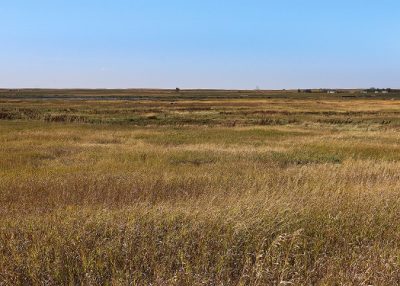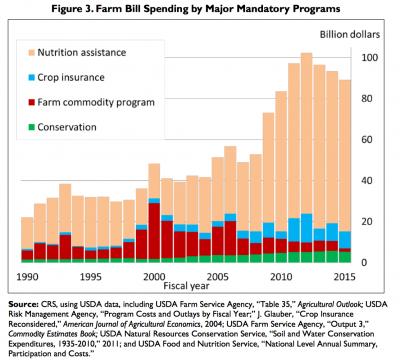Farm Progress' Joshua Baethge reported at the end of last week that "it’s hard to find anyone optimistic about passing a new farm bill this year. While the two political…
House Ag Subcommittee Examines Conservation Issues
Last week, the House Agriculture Committee continued laying groundwork for the next Farm Bill by holding a Subcommittee hearing covering conservation issues.
On Tuesday morning, the House Agriculture Committee’s Subcommittee on Conservation and Forestry held the first hearing “in a series designed to set the stage for the next farm bill.”
Subcommittee Chairman Frank Lucas indicated that, “As Chairman Conaway noted at the rural economic outlook hearing two weeks ago, we are entering this farm bill reauthorization against a much different backdrop. Net farm income has been cut in half over the past 4 years, the steepest 4-year percentage decline since the start of the Great Depression.”
The Oklahoma Republican also pointed out that, “Today we are focusing on the nation’s voluntary conservation initiatives;” and added:
The Conservation title of the 2014 Farm Bill answered the call for meaningful deficit reduction, saving taxpayers $6 billion by consolidating 23 programs into 13, further streamlining and targeting delivery to farmers, ranchers, and foresters.
And Committee Ranking Member Collin Peterson (D., Minn.) stated that, “At the Committee’s recent hearing on the farm economy I expressed my intent to take a good look at the Conservation Reserve Program (CRP) and simplify, reform and increase program acres. We lowered the cap on CRP in the 2014 Farm Bill because we were losing the acres anyway due to high commodity prices. So, because of the way the budget process works, we reduced CRP acres to protect the conservation baseline and help offset some of the cuts in Title 2.
“But, now, I would like to see us get back to 35 or even 40 million acres in this next farm bill. This increase will improve water quality and address the declining wildlife populations we’ve experienced in my region of the country. I think we can find a way to get there but we will need to simplify and reform the program; I wouldn’t support an increase in acres without some changes.”

With respect to CRP, the U.S. Department of Agriculture’s Economic Research Service has explained that, “The 2014 Farm Act reduces the CRP acreage cap by 25 percent from 32 million acres under the 2008 Farm Act to 24 million acres by 2017. Rather than driving program change, however, the lower acreage limit largely reflects the ongoing decline in CRP acreage. Since 2007, CRP acreage has declined steadily from more than 36 million acres to less than 26 million acres at the end of 2013—a drop of about 30 percent. During the same period, the average per-acre CRP payment has increased by 16 percent (inflation-adjusted) and program expenditures have fallen by only about 10 percent in constant dollars.”
A news release on Tuesday from Pheasants Forever indicated that, “Pheasants Forever and Quail Forever testified today before the Subcommittee on Conservation and Forestry regarding important provisions for the upcoming 2018 Farm Bill debate. Dave Nomsen, the organization’s Vice President of Governmental Affairs, appeared for the fourth time in his career in front of the Congressional committee to represent the views of Pheasants Forever and Quail Forever’s 149,000 members, including a recommendation to raise the acreage cap of the Conservation Reserve Program (CRP) to a minimum of 40 million acres.”
The release added that, “Future [CRP] signups should target larger blocks of habitat with the most impact for wildlife populations and soil health over the long-term.”
PF's Nomsen testifies before Congress about stronger CRP in next Farm Bill today https://t.co/PTIWCUCgXS @HouseAgNews @quail4ever pic.twitter.com/9PgvdCiTcP
— Pheasants Forever (@pheasants4ever) February 28, 2017
Oklahoma rancher Chuck Coffey, who testified at last week’s hearing on behalf of the National Cattlemen’s Beef Association, noted that, “U.S. cattlemen own and manage considerably more land than any other segment of agriculture— or any other industry for that matter, [approximately 666.4 million acres.]”
Among the specific variables that the Committee should consider in the next Farm Bill, Mr. Coffey pointed out that, “First and foremost – [the Natural Resources Conservation Service (NRCS)] needs to make it as simple as possible for farmers and ranchers to participate in these programs. Streamlining the application process will garner more producer participation.”
And he added that, “Farmers and ranchers need greater access to programs like [the Conservation Stewardship Program (CSP)], where there is a great demand for these programs but limited funding. I, and cattle ranchers around the country, would like to see CSP simplified and based on outcomes and adaptive management rather than a prescribed set of management practices.”

Also at Tuesday morning’s hearing, Texas farmer Timothy Gertson explained the importance of the cost-share voluntary nature of conservation policy to the Subscommittee, “In the South it is not uncommon for most farmers to rent the majority of their cropland, we have a system that works well for us, usually. Many farmers do not have certainty of whether they will hold the lease on a piece of ground from one year to the next so it is often not worth the risk to invest a lot of capital into someone else’s land.
These cost-share programs are the only thing that help to bridge that gap, allowing land-renters to install conservation measures while footing only a portion of the cost. Improvements in efficiencies benefit the farmer while the environmental perks benefit the landowner by simultaneously raising the land value.
American Farmland Trust (AFT) President John Piotti touched on the Regional Conservation Partnership Program (RCPP) program in his prepared remarks on Tuesday.
The USDA’s Economic Research Service has noted that, “[RCPP] is designed to coordinate conservation program assistance with partners to solve problems on a regional or watershed scale. Financial assistance is coordinated through RCPP but provided to producers largely through ‘covered’ programs: Environmental Quality Incentives Program, Conservation Stewardship Program, Agricultural Conservation Easement Program, and Healthy Forests Reserve Program. Up to 7 percent of the dollars or acres available under each of these programs will be allocated through RCPP.”
Mr. Piotti indicated that, “By 2018, NRCS and its more than 2,000 conservation partners will have invested over $2.4 billion in high-impact RCPP projects nationwide, with more than half of that funding coming from non-federal sources…In Illinois, AFT and partners are working to improve water quality in the Upper Macoupin Creek Watershed, which feeds into the Mississippi River and eventually the Gulf of Mexico. According to the Illinois Nutrient Loss Reduction Strategy, the Macoupin Creek watershed is one of the three highest phosphorus-yielding watersheds in Illinois.”
And DTN Ag Policy Editor Chris Clayton reported on the hearing on Thursday and explained that, “Witnesses also highlighted their concerns about federal agriculture officials ‘inundated in paperwork‘ who as a result are unable to provide the technical advice farmers and ranchers need to improve soil and water quality on their lands. The Natural Resources Conservation Service (NRCS), part of USDA, provides technical and financial assistance to farmers in all 50 states through its voluntary conservation programs. Rep. Frank Lucas, R-Okla., who chairs the subcommittee, agreed that conservation programs can only have value if people are available to provide technical assistance on how to implement them.”
In a related item regarding conservation, a news release from Senate Ag Committee Member John Thune (R., S.D.) on Thursday indicated that, “‘The first [Farm Bill] proposal I’m unveiling would create a new voluntary farm bill program that would provide a short-term option to conserve acreage while protecting farm income. Unlike CRP, which requires a long-term commitment of 10 to 15 years, [the Soil Health and Income Protection Program (SHIPP)] would require only a three-to-five-year commitment. SHIPP would give farmers the flexibility they need to enroll their least productive acreage in this new program in return for a rental payment and additional crop insurance assistance.'”
Unveiled a new income & soil protection program for farmers, the first of many #farmbill proposals I'll introduce this year. #ThuneFarmBill pic.twitter.com/qurnzeUopI
— Senator John Thune (@SenJohnThune) March 2, 2017
The release noted that, “A maximum of 15 percent of the cropland on a [FSA Farm Serial Number] may be enrolled in SHIPP, and to be eligible for SHIPP, land must have been planted or considered planted to a commodity crop for three consecutive years prior to enrollment.”
“Annual SHIPP payment rate shall be one-half of the CRP general sign-up rental per acre rate for the county,” the release said.





